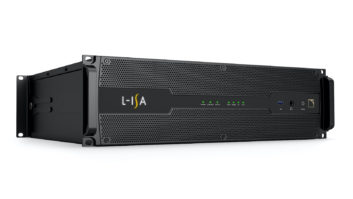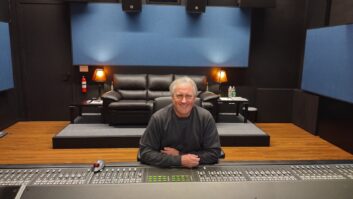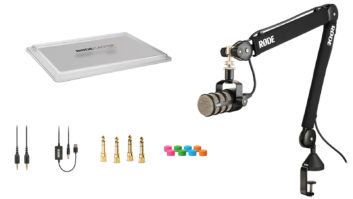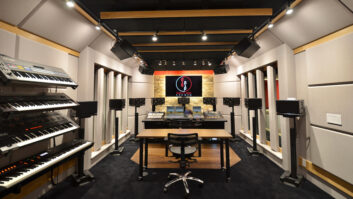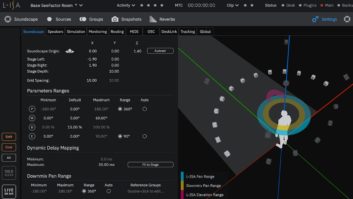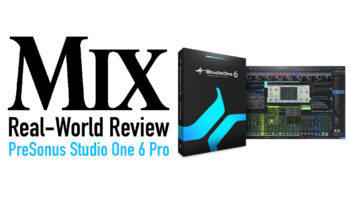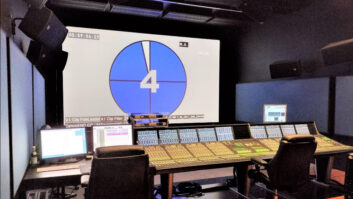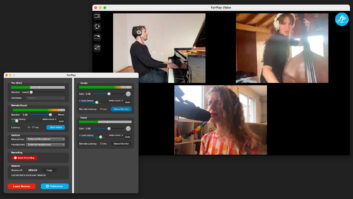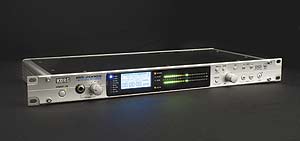
The 2-channel Korg MR-2000S can be ganged and controlled for multichannel recordings.
The Korg MR-2000S is the company’s top-of-the-line MR Series 1-bit recorder. For audio pros concerned about future-proofing their creative work, this unit provides an “insurance policy” against audio file obsolescence. The MR-2000S will play and record DVD-Audio, Super Audio CDs (DSDIFF) and 1-bit DSD at 2.8- and 5.6MHz sample rates. It will also record in PCM WAV up to 192 kHz and 1-bit DSF and WSD at 2.8- and 5.6MHz sample rates. For file archival and management, all audio is stored on its internal 80GB drive and is accessed using a USB 2 interface. Multiple MR-2000S units can be linked for multitrack recording via S/PDIF interconnection.
Toe-to-Toe With 1-Bit
For the setup, I configured my Pro Tools system so I could record simultaneously to a stereo pair “inside the box” and to the MR-2000S using both the unit’s analog and digital inputs. For my first recording test, I clocked the system from my Benchmark Media ADC1 converter/clock at 44.1 kHz and recorded 24-bit WAV files inside Pro Tools and in the MR-2000S. Next, I recorded the same mix using the analog outputs of my Digidesign HD192 IO connected to the MR-2000S’ analog inputs. I chose 1-bit at 5.6 MHz as my sample rate and calibrated the Korg’s analog input to -18 dB (18 dB of headroom) just as my HD192 is calibrated.
I was shocked. Logic tells me that extra D/A and A/D conversions should be detrimental to sound quality; in this case, they were not. The 1-bit “analog” version sounded warmer, more transparent and clear, plus apparently slightly louder. The 44.1kHz digital and inside-the-box versions sounded okay, but not as good as the Korg’s.
Next, at a local studio with a large vintage ’70s API console, I A/B’d the output of the console with MR-2000S’ output, made possible by simultaneous operation of the Cirrus Logic CS4398 D/A and Burr-Brown PCM4202 A/D converter sections while in record or record/pause modes. After calibrating the analog input with a 1kHz tone so that the MR-2000S and console levels matched exactly on the console’s stereo meters, I recorded a mix of an acoustic jazz trio at 96kHz/24-bit in Pro Tools.
“Difference” is almost too strong of a word to describe the extremely subtle change between the MR-2000S at 5.6MHz/1-bit and the console’s stereo bus. The console output “might” have a very minimal and better sub-bass, but the 1-bit was nicer in the top. This test completely sold me!
AudioGate 2.01
While in USB mode, I copied all audio files in the MR-2000S to my computer to use the included AudioGate (Mac/PC) software. AudioGate allows for playlist generation, audio file-format conversion, file division for parsing long performances into individual segments, file joining, gain change, normalization of individual files or entire playlists, fades, adding or removing markers, link mono files into stereo and more. Other formats supported include MP3, Broadcast WAV, AIFF, DSF, AAC, ALAC, FLAC files and WMA.
Projects (songs) of disparate formats can be arranged in any order in a playlist and then exported in any of the previously mentioned formats. There is direct burning of music CDs and DSD (2.8 MHz only) audio discs and support for album artwork and CD-Text data. A choice of either Korg’s AQUA or standard TPDF (Triangular Probability Distribution Function) dither is applied before PCM word-length reduction. I found AudioGate extremely easy and intuitive to use, and I recommend a fast computer and disc burner as DSD files are large — offline processing takes some time.
The Future Is Now
The Korg MR-2000S uniquely provides a future-resistant and elegant archival solution for audio/studio professionals. The MR-2000S’ portable single-rackspace size, ease of operation, internal 80GB hard drive and included AudioGate format-conversion and editing software make it a prescient and prudent investment for anyone who wants to step up to 1-bit.
Barry Rudolph is an L.A.-based recording engineer/mixer. Visit
www.barryrudolph.com.

